Abstract
Web accessibility is essential for e-government in the Philippines to ensure that all citizens, including those with disabilities, can access important information and services. This study evaluates government web accessibility using the Web Content Accessibility Guidelines 2.0 from the World Wide Web Consortium and web presence based on the Government Website Template Design guidelines. A combination of automated testing tools and visual inspections was used for the assessment. Results showed significant discrepancies between web presence and web accessibility. Web presence compliance ranged from 28% to 82.67%, averaging 53.43%. Web accessibility scored higher, with compliance rates ranging from 62.32% to 97.1% and an average of 82.5%. This indicates that while many government agencies have focused on accessibility, there is a need to improve their digital services and visibility. A well-structured and user-friendly website is vital. However, without expanded online services, mobile accessibility, and transactional features, the full potential of digital governance remains untapped. Future studies are directed to aid government agencies with adopting accessible design principles, conducting regular audits, collaborating with disability advocacy groups, and integrating assistive technologies to foster a more inclusive and efficient digital government ecosystem.
1. Introduction
E-government serves multiple purposes, including enhancing administrative efficiency by streamlining processes, promoting democratic governance by facilitating citizen participation and feedback mechanisms, and fostering trust between citizens, the private sector, and governments through increased transparency and accountability [1]. However, achieving these goals has been difficult due to accessibility problems in many e-government websites [2]. This has led to increasing demands for assessing the accessibility of e-government websites, which are widely recognized as the main way for governments to interact with citizens [3]. Several studies have investigated the content of government websites, focusing specifically on their web presence and web accessibility [4,5,6,7]. These studies highlight the critical role of accessible web design in promoting equal opportunities for all users. Research indicates that implementing accessible design features on government websites not only ensures that individuals with disabilities can access information and services but also enhances overall accessibility for all visitors. By incorporating accessible web design principles, government websites can better serve the diverse needs of their citizens and promote inclusivity [8]. Implementing accessible design features not only accommodates the needs of individuals with disabilities but also enhances the overall user experience for all visitors [9]. A strong web presence and web accessibility are of utmost importance in effectively serving e-citizens. This ensures that citizens can easily access information and services, fostering transparency and accountability in governance [10,11].
Government websites can be checked for accessibility compliance by following Web Content Accessibility Guidelines 2.0 standards, which include providing text alternatives, ensuring keyboard accessibility, and making content easy to understand [4,12,13]. Furthermore, web accessibility ensures that individuals with disabilities can equitably perceive, comprehend, navigate, and engage with websites and digital tools [14]. By adhering to the WCAG standards and considering accessibility principles, government websites can enhance the overall user experience and ensure that all citizens, regardless of abilities, can effectively access information and utilize online services. Various approaches have been utilized to conduct these studies, encompassing both automated and manual approaches. According to [15], automated tools can be just as effective as manual methods in pinpointing web accessibility problems. Most studies used automated methods, utilizing popular tools such as the Web Accessibility Evaluation (WAVE) Tool, Google Lighthouse, and Test d’Accessibilitat Web (TAW) [16,17,18,19].
In the Philippines, the legal basis of web accessibility can be traced back to several laws and policies. The most notable among these is the Republic Act No. 7277, or the Magna Carta for Persons with Disabilities (PWDs) [20]. This law mandates the government to ensure that PWDs are provided with equal opportunities, particularly in the field of education, employment, and accessibility to public facilities and services, including information and communication technology. The National Council on Disability Affairs issued the Implementing Rules and Regulations of the Magna Carta, which explicitly states that “all government websites shall comply with the guidelines on web accessibility” [21]. Additionally, the Department of Information and Communications Technology (DICT) issued Memorandum Circular 004 (2017), a policy that provides guidelines on the implementation of web accessibility in government websites [22]. The memorandum circular provides specific guidelines for achieving web accessibility, including the use of alternative text for non-text content, the provision of captions and transcripts for multimedia content, and the use of descriptive links and headings. It also requires government agencies to conduct regular accessibility audits of their websites and web-based applications to ensure compliance with the WCAG 2.0 Level AA. Moreover, the memorandum circular mandates the establishment of a web accessibility compliance team within each government agency, responsible for ensuring compliance with web accessibility guidelines and conducting regular accessibility audits of the agency’s website [23]. These laws and policies serve as the legal basis for the implementation of web accessibility standards in the Philippines, particularly for the benefit of PWDs. According to the 2010 Census of Population and Housing in the Philippines, 1.44 million individuals, or 1.57% of the 92.1 million household population, have a disability [24,25].
Despite these policies, the overall accessibility of the Philippine government websites remains a concern. According to the United Nations E-Government Development Index, the Philippines ranks 73rd globally in e-government development [26]. This ranking reflects the country’s progress in digital governance but also underscores the need for further improvement in accessibility. In this context, evaluating the accessibility of government websites is essential to determine whether accessibility challenges stem from design and compliance issues or broader factors related to the digital divide. This ensures that web accessibility remains essential in promoting inclusivity and equal access to government services and digital resources. Governments must prioritize accessibility improvements to accommodate the needs of persons with disabilities, thereby fostering a more inclusive digital environment.
As such, this study aims to contribute to the existing knowledge by evaluating the web presence and accessibility of e-government websites in the Philippines. This endeavor is particularly significant considering the limited understanding of e-government website accessibility within the country. Ensuring equitable access to government services for all citizens, including those with visual, auditory, dexterity, and cognitive impairments, is imperative. This evaluation is important because it will help identify any barriers or challenges that may exist and provide recommendations for improving accessibility. Having an accessible website supports government agencies in their commitment to serving all members of the public equally.
2. Accessibility Issues and Concerns
2.1. Visual Impairments
Accessibility is a crucial aspect of ensuring equal access and opportunities for individuals with disabilities in various settings, including digital platforms [27]. In the context of visual difficulties, individuals with disabilities may face challenges in accessing content that relies solely on visual cues such as images, videos, and diagrams [28,29]. This can impact their ability to understand and engage with the information presented. Numerous studies have highlighted the difficulties faced by individuals with visual impairments when accessing digital content. For example, a study conducted by [30] found that only 2.4% of research articles delivered in a PDF format were accessible to people with disabilities. In terms of reading text, individuals with visual difficulties may also struggle with text that is too small or not presented in a high-contrast format. This can make it challenging for them to read and comprehend the content effectively. For individuals with visual difficulties, developers can implement alternative text for images and graphics, allowing screen readers to describe the content to users who are unable to see it. Additionally, providing options to adjust text size and contrast can greatly improve readability for individuals with visual impairments [31].
2.2. Auditory Impairments
Individuals with auditory disabilities may encounter barriers when audio content is not adequately transcribed or captioned. This can significantly hinder their access to information presented through podcasts, videos, and other audio-based media [32]. Moreover, individuals with auditory difficulties may face challenges with poorly designed sound interfaces or systems that do not accommodate their specific needs, affecting their overall user experience [33]. In a study conducted by [34], it was found that a majority of online videos lack accurate captions, making it challenging for individuals with auditory impairments to fully comprehend the content. Furthermore, there is a need for developers to address these accessibility issues by incorporating features that cater to individuals with visual and auditory impairments. For individuals with auditory difficulties, developers should ensure that all audio content is accompanied by accurate transcriptions or captions. This not only benefits individuals with hearing impairments but also provides a better user experience for all users, especially in noisy environments where audio may be difficult to hear.
2.3. Dexterity Impairments
Individuals with dexterity impairments may encounter challenges in navigating digital interfaces that require precise and coordinated movements, such as using a mouse or typing on a keyboard [35]. This can limit their ability to interact with websites, applications, and other digital platforms effectively. Developers and designers can address these challenges by implementing features such as keyboard shortcuts, voice command options, and customizable input methods. These accommodations can provide individuals with dexterity impairments the flexibility to interact with digital content in a way that suits their abilities and needs.
2.4. Cognitive Differences
In the context of cognitive differences, individuals with disabilities may face additional challenges when interacting with digital content [36]. For example, individuals with cognitive differences may have difficulty processing complex information or navigating websites with cluttered layouts. Developers and designers can address these challenges by simplifying the language used in content, providing clear navigation paths, and minimizing distractions on the interface. Furthermore, individuals with cognitive differences may benefit from features such as visual cues, consistent layout designs, and the option to customize the display settings to reduce cognitive overload. By incorporating these features, developers can create a more inclusive digital environment that caters to individuals with cognitive differences.
It is evident that there are numerous accessibility issues and concerns that individuals with disabilities face when interacting with digital content [37]. The lack of accommodations for visual, auditory, dexterity, and cognitive impairments can create significant barriers to equal access and opportunities. It is crucial for developers and designers to prioritize accessibility in their digital platforms by implementing features such as alternative text for images, accurate transcriptions or captions for audio content, customizable input methods for dexterity impairments, and simplified language and clear navigation for cognitive differences [38]. By doing so, they can create a more inclusive digital environment that caters to individuals with disabilities, ultimately promoting equal access and participation for all users.
3. Methodology
3.1. Web Accessibility Framework
To fully achieve an inclusive Philippine government agency website, it is imperative that the platform meets the requirements for both web presence and web accessibility, as illustrated in Figure 1. Web presence enables agencies to provide a platform for publishing essential information to the public, thereby facilitating access to vital services and resources [39]. Meanwhile, web accessibility ensures that all users, including individuals with disabilities, can perceive, understand, navigate, and interact with websites and related tools on an equal basis [14]. A website that effectively incorporates both accessibility and presence maximizes its reach, ultimately serving a diverse population with varying needs.
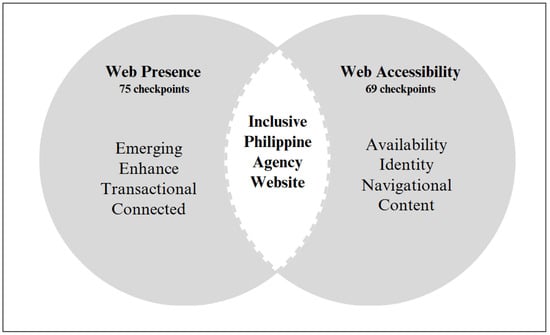
Figure 1.
Web accessibility framework for Philippine government website (made by the authors).
3.2. Web Presence
Web presence enhances a website’s online visibility, enabling users to access essential information, services, and resources. Evaluators assess government websites using 75 checkpoints outlined in the Government Website Template Design guidelines, which align with the Memorandum Circular of the Government Web Hosting Service issued by the Department of Science and Technology-Information and Communications Technology [40]. The Philippine government developed the GWTD initiative to standardize the design, navigation, and content of government websites, ensuring a unified online identity across agencies. These guidelines specify website structure, required sections, design specifications, and additional features to enhance functionality and accessibility. A government website achieves compliance when it meets at least 80% of these checkpoints, allowing it to effectively serve and engage with citizens [41]. A well-structured web presence enables government agencies to provide accessible services and information, fostering greater transparency and accountability in public administration [42]. A total of 75 checkpoints are included across all web presence categories, as shown in Table 1.

Table 1.
Web presence stages [39].
3.3. Web Accessibility
Web accessibility ensures that all users, including those with disabilities, can effectively access, perceive, understand, navigate, and interact with websites [43]. Evaluators use 69 checkpoints from the Web Content Accessibility Guidelines (WCAG) 2.0, developed by the World Wide Web Consortium (W3C), to assess accessibility [14]. A website achieves full compliance by meeting 100% of these checkpoints, partial compliance by satisfying 85% to 99%, and non-compliance if it falls below 85%. Government agencies depend on accessible websites to provide citizens with seamless access to information, services, and public engagement opportunities. A well-designed, accessible website promotes efficiency, inclusivity, and transparency in digital governance. Table 2 presents the 69 accessibility checkpoints.

Table 2.
Web accessibility sections [14].
3.4. Website Selection
This study obtained a comprehensive list of government websites by accessing the official government directories of websites. The list includes the URLs of these government websites for easy access. Each selected website was visited and evaluated for its website presence and accessibility. A total of 45 government websites were obtained. Among these websites, 37 were found to have corresponding URLs. Upon further evaluation, it was discovered that out of the 37 websites with URLs, only 27 were accessible and visible. Table 3 shows the list of 27 government websites that were utilized for evaluating web presence and web accessibility.

Table 3.
List of government agency websites.
3.5. Evaluation Procedure
The evaluation of government websites followed a systematic process comprising three main steps: (1) accessing the URL, (2) inspecting the website, and (3) verifying compliance with 144 checkpoints, including 75 web presence checkpoints and 69 web accessibility checkpoints. The evaluation criteria were based on the Government Website Template Design guidelines and the Web Content Accessibility Guidelines 2.0 [14,40]. Each website was assessed sequentially, beginning with web presence checkpoints, followed by web accessibility checkpoints. The evaluation was conducted by researchers who are also web development specialists with prior training in web accessibility audits through a Training of Trainers program organized by the Department of Information and Communications Technology. The evaluation took place between June and August 2024.
To ensure a comprehensive assessment, this study employed a combination of automated testing tools and visual inspection. Prior research indicates that combining these methods enhances the accuracy of webs accessibility assessments [44,45,46,47].
Visual inspection was utilized for accessibility criteria that require manual verification. The following key elements were assessed: (1) checking if the website has a home page linked to a home menu; (2) ensuring that the Philippine Standard Time is displayed, preferably on the homepage; (3) verifying the presence of agency information, such as the agency name and logo, “About Us” section, organizational structure, key officials, and contact details; (4) confirming that the Citizen’s Charter is accessible; (5) checking if all required items are included in the transparency page; (6) ensuring the availability of a downloads’ page; (7) verifying that a search bar is present and prominently placed; (8) checking for the presence of online forms, surveys, or feedback mechanisms, ensuring the website offers a language-switching feature; (9) confirming the inclusion of a calendar of activities related to e-participation; (10) ensuring that these elements were evaluated based on the Government Website Template Design guidelines [40].
Automated testing tools were employed to systematically analyze website elements, ensuring comprehensive coverage of accessibility criteria. Although these tools facilitate large-scale assessments, it is important to recognize their limitations, as they may not detect all accessibility issues [46]. In contrast, visual inspection offers a qualitative perspective, identifying accessibility barriers that automated tools might overlook [47]. By leveraging a combination of automated testing tools and visual inspection, this study ensured a more robust and reliable evaluation framework. The specific tools used for automated assessments are presented in Table 4.

Table 4.
Automated tools used for evaluation.
Upon completing the accessibility inspections, researchers documented compliance with the designated checkpoints, identified accessibility barriers, and formulated recommendations for website enhancements. The collected data were systematically analyzed to derive meaningful insights and contribute to future accessibility improvements in government web platforms.
Automated tools can efficiently detect common accessibility barriers such as missing ALT text, inadequate color contrast between background and foreground, and issues related to keyboard navigation and form controls. However, they may not capture the full range of potential accessibility concerns. Automated tools can struggle to detect context-based errors, such as improper use of Accessible Rich Internet Applications or the nuances of how screen readers interpret content. Therefore, it is essential to perform visual inspections alongside automated checks, particularly to verify the accuracy of results in areas like ALT text descriptions, color contrast, and other critical evaluation checkpoints. Visual inspections allow evaluators to ensure that the automated tools’ findings align with real-world user experience and accessibility guidelines, addressing technical compliance and accessibility considerations for individuals with diverse disabilities. This dual approach—combining automated evaluation with manual inspection—enhances the reliability of the accessibility audit, ensuring that websites provide a truly inclusive experience for all users.
4. Results
4.1. Web Presence Results
The compliance of various government agencies with different stages of web presence is assessed based on four categories—(1) Emerging, (2) Enhanced, (3) Transactional, and (4) Connected—with corresponding compliance percentages for each stage.
Figure 2 shows the emerging web presence stage. Overall, the websites achieved an average compliance rate of 79.34% on the 26 checkpoints. Furthermore, 16 out of 27 websites successfully met the required percentage of 80%. The agencies that demonstrated the highest compliance rates were DENR, DOST, and DTI, each achieving a compliance rate of 92.31% or 24 checkpoints. Conversely, NSC exhibited the lowest compliance rate with only 38.46% or 10 checkpoints.
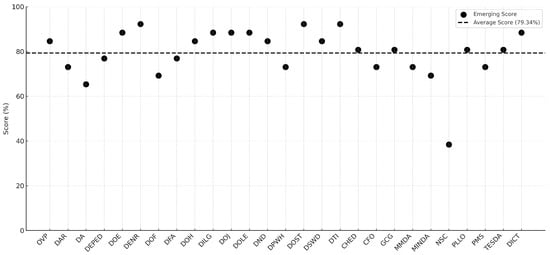
Figure 2.
Result of the emerging web presence stage.
Figure 3 shows Stage 2, enhanced web presence, with the compliance percentage significantly dropping in all websites, averaging at 63.83%. Only two websites, DTI with 88.24% and OVP with 82.35%, were able to surpass the required percentage. This indicates that 93% (25) of the websites failed to meet the minimum requirement of 80% compliance for web presence.
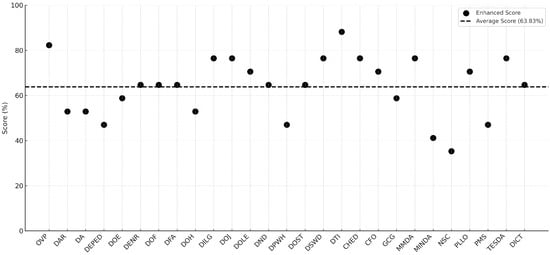
Figure 3.
Result of the enhanced web presence stage.
Figure 4 shows Stage 3, transactional web presence, with none of the websites being able to meet the required percentage of 80%. The average compliance rate across all websites is only 40.74%. The highest percentage compliance rate achieved was 66.67% by DEPED, DOST, and DSWD.
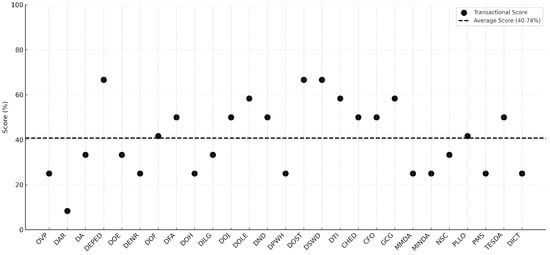
Figure 4.
Result of the transactional web presence stage.
Finally, Figure 5, connected web presence, shows that the overall compliance percentages for all agencies are relatively low, with an average of 18.52%. However, DTI stands out with a compliance rate of 80%, being the only website that passed the required percentage. On the other hand, the remaining websites fall below 40% compliance. This highlights the high level of web interactivity and data exchange required in Stage 4.
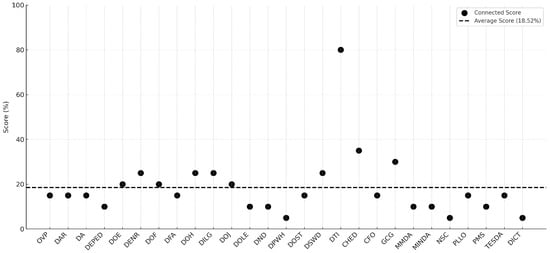
Figure 5.
Result of the connected web presence stage.
Table 5 shows the number of web presence compliant and non-compliant checkpoints for each government agency. Only the DTI website passed with a percentage of 82.67%, while the NSC had the lowest compliance percentage of 28%. Overall, the average compliance percentage for all government agencies in all four stages was 53.43%, indicating that there is still much room for improvement in their web presence. Government agencies should focus on enhancing their websites to improve compliance with web presence stages.

Table 5.
Web presence checkpoints with compliance rate.
4.2. Web Accessibility Results
The results of the government agency websites’ evaluation in terms of accessibility, specifically in the areas of availability, identity, navigation, and content.
Figure 6 shows the availability section, which focuses on how easy it is for all users to access and use the website. The figure shows that most government agency websites scored well in this section, with an average score of 85.19%. Specifically, 16 out of 27 agencies scored above 85%, with the highest score being 100% for DICT. The agencies with the lowest score of 64.71% were DOH, DOST and DSWD.
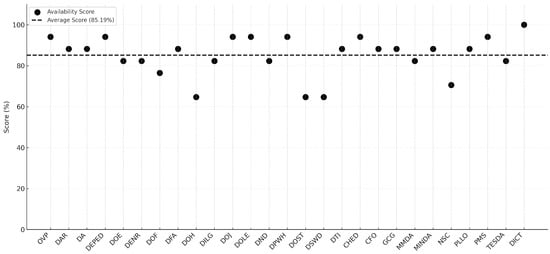
Figure 6.
Result of the availability section.
In the identity section, Figure 7 shows that government agency websites have an average score of 78.60%. This section refers to how well a website’s design reflects the agency’s identity and branding. Only 8 out of 27 agencies scored above 85%, with the highest score being 94.44% for DTI and CFO. On the other hand, five agencies, DEPED, DFA, DND, NSC and PMS, scored below 70%, which indicates a need for improvement in their website design to better reflect their identity and branding.
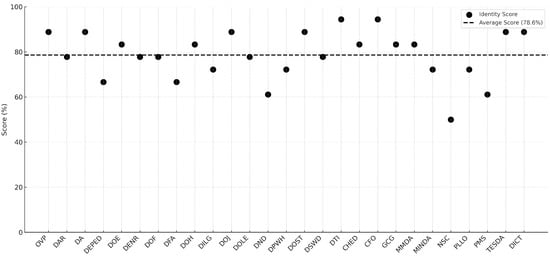
Figure 7.
Result of the identity section.
Figure 8 shows the navigation section, which measures how easily users can navigate the government agency websites. It indicates that most government agency websites scored well in this section, with an average score of 86.24%. Specifically, 20 out of 27 agencies scored above 85%, with the highest score being 100% for DA and DICT. On the other hand, the agencies with the lowest scores were DND, DPWH, DSWD, MMDA, MINDA, NSC and PMS, scoring below 80%. It is worth noting that navigation is crucial in ensuring a user-friendly website, as it affects user experience and engagement.
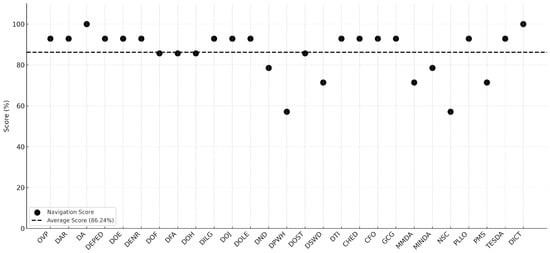
Figure 8.
Result of the navigation section.
Finally, Figure 9 shows the content section, which refers to the information displayed on the government agency websites. From the figure, it can be seen that DFA, DOJ, DPWH, CHED and DICT are fully compliant with the content checkpoints with a score of 100%. OVP, DOE, DENR, DILG, DOLE, DTI, CFO, MMDA and MINDA are partially compliant with scores above 85%. On the other hand, DAR, DA, DEPED, DOH, DND, DOST, DSWD, GCG, NSC, PLLO, PMS and TESDA scored below 85%, indicating that they are non-compliant with the content checkpoints. The average score for this section is 81.11%, indicating that there is still a need for improvement in the content displayed on government agency websites.
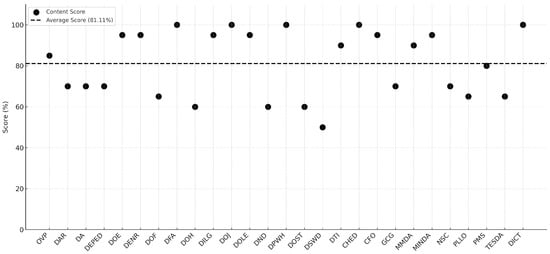
Figure 9.
Result of the content section.
Table 6 shows the number of web accessibility compliant and non-compliant checkpoints as well as the overall compliance percentage of each government agency. The average overall percentage of compliance for all agencies is 82.50%. Specifically, 12 out of 27 agencies were classified as partially compliant and scored above 85%, with the highest score being 97.10% for DICT. However, 15 out of 27 agencies were considered non-compliant, with the lowest score being 62.32% for NSC. Overall, there is room for improvement for the government agency websites in terms of meeting the accessibility standards.

Table 6.
Web accessibility checkpoints with compliance rate.
4.3. Comparative Analysis
The distribution highlights varying levels of compliance with web presence and accessibility standards among government agencies in Figure 10.
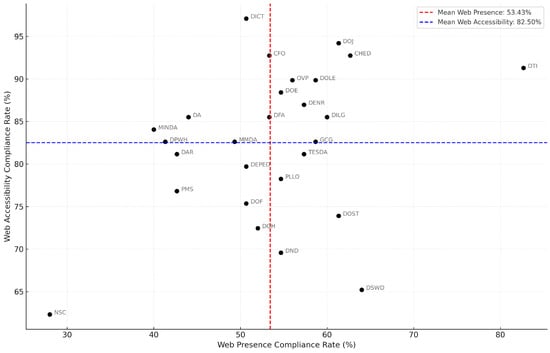
Figure 10.
Analysis across government agencies.
Some agencies demonstrate high accessibility scores but have a low web presence, such as the Department of Information and Communications Technology, Department of Agriculture, and Mindanao Development Authority. This indicates that while they comply with web accessibility checkpoints, they need to enhance their web presence. Other agencies, such as the National Security Council, Presidential Management Staff, Department of Education, Department of Finance, and Department of Health, exhibit both low web presence and poor accessibility, characterized by outdated interfaces, poor navigation, and limited online services. These agencies must improve in both areas to enhance digital accessibility and service delivery. In contrast, a few agencies, including the Department of Trade and Industry, Commission on Higher Education, Department of Justice, Department of Labor and Employment, and Department of Environment and Natural Resources, reflect strong accessibility and web presence. Their successful integration of interactive design, improved navigation, and enhanced user experience suggests progress toward more advanced stages of web presence. These agencies should serve as benchmarks for others seeking to improve their digital platforms. Moving forward, government agencies should target a holistic approach that strengthens both web presence and accessibility to achieve a full connected and citizen-centric digital government.
5. Discussion
The evaluation of government websites in the Philippines across different web presence stages reveals varying levels of compliance with the checkpoints from GTWD and WCAG 2.0.
5.1. Web Presence
The web presence evaluation reveals an average compliance rate of 53.43% across all government websites, with a declining trend as they progress through the stages: 79.34% (Emerging), 63.83% (Enhanced), 40.74% (Transactional), and 18.52% (Connected). This decrease highlights the need for government agencies to improve their web presence, particularly in later stages where higher interactivity and integration introduce accessibility challenges [39]. Web presence initially serves as a basic platform, providing static information with limited citizen engagement [48]. As websites evolve into transactional and connected stages, they enable two-way communication and online services. However, the drop in compliance rates at advanced stages suggests that as governments strive for greater digital integration, they often struggle to maintain accessibility standards. Addressing these gaps is essential to ensuring that government websites remain functional, accessible, and user-friendly, especially as they transition into the transactional and connected stages of e-government.
Table 7 shows checkpoints with a compliance rate below 50% that needs to be compiled by government agency websites. Each checkpoint plays a vital role in ensuring adherence to standards and optimizing the user experience. In Stage 1 (Emerging), accurately displaying the local time—particularly aligning with Philippine Standard Time—is essential for users to efficiently synchronize with schedules, deadlines, and events. The Emerging Site Map and Citizen’s Charter serve as foundational tools that enhance navigation and transparency, helping users understand government processes and services [49]. Additionally, archives act as a crucial repository of historical data, providing valuable reference points for those seeking past records and information.

Table 7.
Web presence checkpoints with a compliant rate below 50%.
Advancing to Stage 2 (Enhanced), support for multiple languages fosters inclusivity by accommodating diverse linguistic backgrounds, ensuring that non-native speakers can access information seamlessly. Strengthened user login and password security features enhance data protection while maintaining a smooth authentication process. Additionally, the integration of wireless technology for mobile messaging enables instant communication and updates, improving responsiveness and citizen engagement [50].
In Stage 3 (Transactional), implementing CAPTCHA reinforces security measures, preventing automated bots and unauthorized access. Transactional e-mail alerts keep users informed about updates, requests, and service statuses, ensuring timely communication. Moreover, features such as confirmation of request and e-signatures enhance verification and authorization processes, strengthening the security and credibility of digital transactions [51].
Finally, in Stage 4 (Connected), discussion forums play a crucial role in promoting public discourse, fostering collaboration, and enhancing engagement among users. In parallel, opinion polls serve as a vital tool for gathering citizens’ feedback, which can directly influence policy making and service improvements. By addressing these low-compliance checkpoints, government agencies can significantly enhance their digital presence, improve accessibility, and offer more efficient and effective online services. It is essential for these agencies to prioritize these improvements in order to create more inclusive, user-friendly, and responsive digital platforms that meet evolving technological standards and user expectations. Indama (2022) suggests that, to truly enhance the effectiveness and equity of digital public services, policymakers and practitioners must adopt a citizen-centric approach that prioritizes accessibility, inclusivity, engagement, and ethical considerations [52]. Such an approach ensures that digital governance not only meets current demands but also addresses the diverse needs and expectations of the public.
5.2. Web Accessibility
Government agencies have an average compliance rate of 82.5%, showing notable progress toward meeting accessibility standards. However, this falls short of the 85% threshold, which is generally considered the benchmark for partial compliance. Although this indicates positive development, the gap highlights that government websites continue to face challenges in achieving full accessibility, which is a critical aspect for inclusivity and effective public service delivery.
Table 8 shows various sections and their corresponding checkpoints with a compliance rate below 65%, requiring improvement. Adherence to these checkpoints ensures that the website is accessible to all users, promoting inclusivity and compliance with web accessibility standards. In the availability section, it stands at 85.19%, reflecting that most government websites successfully provide the essential content and services expected by users. According to the World Wide Web Consortium, availability is a cornerstone of web accessibility, ensuring that users can access important information without encountering technical barriers [14]. In terms of areas for improvement, images must consistently have appropriate ALT tags, and the use of flash and add-ons should be minimized to prevent accessibility issues.

Table 8.
Web accessibility checkpoints with a low compliant rate.
Identity compliance, at 78.60%, reveals challenges in establishing consistent digital identity management systems across government websites. This is a crucial issue as digital identity systems become increasingly integral to online services, requiring both security and accessibility. Areas for improvement include feedback forms, key official corners, and contact details such as mobile and fax numbers. Incomplete compliance in this area may limit access to services for users, particularly those with disabilities. A study of Singh (2020) has shown that poor identity verification systems can severely hinder the accessibility of government services for a wide range of users [47].
Navigation compliance, with a rate of 86.94%, suggests that government websites are becoming increasingly user-friendly, enabling users to navigate the sites more efficiently. Government agencies have also integrated mobile features to enhance service accessibility and citizen engagement. However, despite these technological advancements, many agencies still lack fully responsive designs or dedicated mobile applications, as highlighted in the navigation section. This indicates a need for government agencies to expand their digital strategies, ensuring seamless mobile responsiveness and cross-platform accessibility to accommodate a growing and diverse digital user base [53].
There are still areas for improvement, such as indicating the user’s current location on the site and providing a well-organized site map or index when needed. As emphasized in Lawrence (2024) study, ease of navigation is critical for accessibility, especially for users with disabilities, and it plays a significant role in how effectively users can interact with the site [54].
Content compliance, currently at 81.11%, highlights ongoing challenges in ensuring that all content on government websites is accessible, especially for users with visual impairments or cognitive disabilities [28]. Improvements are needed in various areas, such as ensuring decorative images are assigned null ALT text (alt=“”) or used as CSS backgrounds, correctly associating text labels with form inputs, labeling embedded multimedia content with accessible text, and ensuring all images (including image buttons and hotspots on image maps) have suitable alternative text. Additionally, every linked image must have descriptive alternative text, and meta descriptions should be provided where necessary.
According to the Web Content Accessibility Guidelines 2.0, a website should be perceivable, operable, understandable, and robust for users with various disabilities [14]. Although progress has been made, much work remains to ensure that all content, including multimedia and dynamic elements, fully meets these standards.
The results indicate that government websites must continue to prioritize accessibility improvements to meet the needs of all users, especially as digital services become increasingly essential. Addressing gaps in identity and content accessibility will be crucial for creating a truly inclusive digital government, ensuring that all citizens, regardless of ability, can access vital public services. These findings align with the broader push for accessibility in digital governance, as outlined by the United Nations’ e-Government Survey, which advocates for universal access to government services online [55].
6. Conclusions and Recommendations
The evaluation of web accessibility for government agencies in the Philippines highlights critical areas for improvement in compliance with the Government Website Template Design guidelines and the Web Content Accessibility Guidelines 2.0 established by the World Wide Web Consortium.
The findings revealed significant discrepancies between web presence and web accessibility. Compliance rates for web presence ranged from 28% to 82.67%, with an average of 53.43%. Notable gaps were found in the transactional and connected stages, where engagement and interactive services should be more robust. To improve their web presence, government agencies must focus on addressing low-compliance areas, such as missing ALT tags in the availability section, incomplete contact information in the identity section, unclear navigation features in the navigation section, and inadequate meta descriptions or form labels in the content section. The connected web presence stage, which represents a fully integrated digital ecosystem, showed a concerning 0% compliance rate, highlighting significant issues with system interoperability and seamless online services. Overall, the compliance rates for web presence across all government agencies remain critically low, underscoring the urgent need to enhance integration, data sharing, and interoperability.
In contrast, web accessibility scored higher, with compliance rates ranging from 62.32% to 97.1% and an average of 82.5%. This suggests that while significant progress has been made in ensuring websites are accessible to users, there are still areas in need of improvement. Some government agencies in the Philippines have already adopted mobile integration to enhance service accessibility and citizen engagement. However, despite these advancements, many agencies still lack fully responsive designs or dedicated mobile applications, as reflected in the navigation section of the web accessibility evaluation. This underscores the need for government agencies to expand their digital strategies, ensuring seamless mobile responsiveness and multi-platform accessibility to cater to a diverse and growing digital user base.
A comparative analysis of web presence and web accessibility further underscores this need. Although web accessibility scores remain high, web presence compliance is relatively lower. This indicates that many government agencies have prioritized accessibility improvements but may still need to strengthen their digital services and visibility. A well-structured and user-friendly website is crucial, but without expanded online services, mobile accessibility, and transactional features, the full potential of digital governance remains underutilized.
To fully optimize government websites, agencies must invest in digital transformation efforts, mobile integrations, enhanced interoperability, and strengthened online service capabilities. Future studies are directed to aid government agencies to adopt accessible design principles, conduct regular accessibility audits, collaborate with disability advocacy groups, and integrate assistive technologies into their website evaluation processes to create a more inclusive and efficient digital government ecosystem.
Author Contributions
Conceptualization, P.B.J. and A.G.; methodology, P.B.J. and J.J.E.; validation, P.B.J. and J.J.E.; formal analysis, P.B.J., J.J.E. and J.B.; investigation, P.B.J., J.B., J.J.E., N.B. and A.R.A.; resources, P.B.J., J.B., J.J.E. and A.G.; data curation, P.B.J. and J.J.E.; writing—original draft, P.B.J., J.J.E., J.B. and A.G.; writing—review and editing, P.B.J., J.J.E., J.B. and A.G.; visualization, P.B.J. and J.J.E.; supervision, P.B.J. and A.G.; project administration, P.B.J. All authors have read and agreed to the published version of the manuscript.
Funding
This research, including the article processing charge (APC), was funded by the Mindanao State University-Iligan Institute of Technology through the Office of Research Management, under the Office of the Vice Chancellor for Research and Enterprise SO# 00503-2023.
Institutional Review Board Statement
Not applicable.
Informed Consent Statement
Not applicable.
Data Availability Statement
The original contributions presented in this study are included in the article. Further inquiries can be directed to the corresponding author.
Acknowledgments
This research was supported and funded by Mindanao State University-Iligan Institute of Technology (MSU-IIT). Their generous contribution was instrumental in enabling us to carry out this study and achieve the research objectives. We express our sincere gratitude to MSU-IIT for their unwavering support in promoting academic excellence and research endeavors. Moreover, while preparing this manuscript, we used ChatGPT (GPT-4o) solely for paraphrasing text to improve clarity and coherence as well as for generating LaTeX code for formatting in Overleaf. However, all analyses, interpretations, and conclusions in this manuscript remain the authors’ original work.
Conflicts of Interest
The authors declare no conflicts of interest.
References
- Grigalashvili, V. E-Government and E-Governance: Various or Multifarious Concepts. Int. J. Sci. Manag. Res. 2022, 5, 183–196. [Google Scholar] [CrossRef]
- Palma, J.P.B.; Avila, L.S.; Mag-iba, M.A.J.; Buman-eg, L.D.; Nacpil Jr, E.E.; Dayrit, D.J.A.; Rodelas, N.C. E-Governance: A Critical Review of E-Government Systems Features and Frameworks for Success. Int. J. Comput. Sci. Res. 2023, 7, 2004–2017. [Google Scholar] [CrossRef]
- Baroudi, M.; Alia, M.; Marashdih, A.W. Evaluation of Accessibility and Usability of Higher Education Institutions’ Websites of Jordan. In Proceedings of the 2020 11th International Conference on Information and Communication Systems (ICICS), Irbid, Jordan, 7–9 April 2020. [Google Scholar] [CrossRef]
- Al-Sakran, H.O.; Alsudairi, M.A. Usability and Accessibility Assessment of Saudi Arabia Mobile E-Government Websites. IEEE Access 2021, 9, 48254–48275. [Google Scholar] [CrossRef]
- Agrawal, G.; Kumar, D.; Singh, M. Assessing the Usability, Accessibility, and Mobile Readiness of E-Government Websites: A Case Study in India. Univers. Access Inf. Soc. 2022, 21, 737–748. [Google Scholar] [CrossRef]
- Legaspi, P.E.; Marigza, R.B. Exploring and Assessing Government Website as an Instrument of E-Governance at the Local Government Level in Pangasinan. ASEAN Multidiscip. Res. J. 2021, 9, 126–141. [Google Scholar]
- Bakhsh, M.; Mehmood, A. Web Accessibility for Disabled: A Case Study of Government Websites in Pakistan. In Proceedings of the 2012 10th International Conference on Frontiers of Information Technology, Islamabad, Pakistan, 17–19 December 2012. [Google Scholar] [CrossRef]
- Othman, A.; Al Mutawaa, A.; Al Tamimi, A.; Al Mansouri, M. Assessing the Readiness of Government and Semi-Government Institutions in Qatar for Inclusive and Sustainable ICT Accessibility: Introducing the MARSAD Tool. Sustainability 2023, 15, 3853. [Google Scholar] [CrossRef]
- Malodia, S.; Dhir, A.; Mishra, M.; Bhatti, Z.A. Future of E-Government: An Integrated Conceptual Framework. Technol. Forecast. Soc. Change 2021, 173, 121102. [Google Scholar] [CrossRef]
- Lujan-Mora, S.; Navarrete, R.; Penafiel, M. Egovernment and Web Accessibility in South America. In Proceedings of the 2014 First International Conference on eDemocracy and eGovernment (ICEDEG), Quito, Ecuador, 24–25 April 2014. [Google Scholar] [CrossRef]
- İşeri, E.İ.; Uyar, K.; İlhan, Ü. The Accessibility of Cyprus Islands’ Higher Education Institution Websites. Procedia Comput. Sci. 2017, 120, 967–974. [Google Scholar] [CrossRef]
- Csontos, B.; Heckl, I. Accessibility, Usability, and Security Evaluation of Hungarian Government Websites. Univers. Access Inf. Soc. 2021, 20, 139–156. [Google Scholar] [CrossRef]
- Murah, M.Z.; Ahmed, A. Web Assessment of Libyan Government e-Government Services. Int. J. Adv. Comput. Sci. Appl. 2018, 9, 583–590. [Google Scholar] [CrossRef]
- W3C-WAI. Web Content Accessibility Guidelines (WCAG). Available online: https://www.w3.org/WAI/standards-guidelines/wcag/ (accessed on 5 August 2024).
- Iannuzzi, N.; Manca, M.; Paternò, F.; Santoro, C. Usability and Transparency in the Design of a Tool for Automatic Support for Web Accessibility Validation. Univers. Access Inf. Soc. 2024, 23, 435–454. [Google Scholar] [CrossRef]
- Ismailova, R.; Inal, Y. Comparison of Online Accessibility Evaluation Tools: An Analysis of Tool Effectiveness. IEEE Access 2022, 10, 58233–58239. [Google Scholar] [CrossRef]
- Mañez-Carvajal, C.; Cervera-Mérida, J.F.; Fernández-Piqueras, R. Web Accessibility Evaluation of Top-Ranking University Websites in Spain, Chile, and Mexico. Univers. Access Inf. Soc. 2021, 20, 179–184. [Google Scholar] [CrossRef]
- Akgül, Y. Accessibility, Usability, Quality Performance, and Readability Evaluation of University Websites of Turkey: A Comparative Study of State and Private Universities. Univers. Access Inf. Soc. 2021, 20, 157–170. [Google Scholar] [CrossRef]
- Adepoju, S.A.; Shehu, I.S.; Bake, P. Accessibility Evaluation and Performance Analysis of e-Government Websites in Nigeria. J. Adv. Inf. Technol. 2016, 7, 49–53. [Google Scholar] [CrossRef]
- Cabauatan, A.J. The Politics of Inclusion: Perspectives on Persons with Disabilities in Society; Alexis Jose Cabauatan: Santiago City, Philippines, 2024. [Google Scholar]
- Susmerano, E.B.; Yamada, K. Revisiting Auxiliary Social Services for Persons with Disability: The Philippines Case. Int. J. Soc. Welf. 2022, 31, 187–202. [Google Scholar] [CrossRef]
- Salvio, K.B.V. Extending the Evaluation on Philippine E-Government Services on its Accessibility for Disabled Person. In Proceedings of the 2020 Fourth World Conference on Smart Trends in Systems, Security and Sustainability (WorldS4), London, UK, 27–28 July 2020. [Google Scholar] [CrossRef]
- DICT. DICT Memo Circular 2019. Available online: https://www.pwag.org/wp-content/uploads/2020/01/DICT-Memo-Circular-2019-04-txt-format.txt (accessed on 21 July 2024).
- Authority, P.S. Persons with Disability in the Philippines: Results from the 2010 Census. Available online: https://psa.gov.ph/content/persons-disability-philippines-results-2010-census (accessed on 21 July 2024).
- Red, G.V.; Palaoag, T.D.; Naz, V.A. Creating a Framework for Care Needs Hub for Persons with Disabilities and Senior Citizens. Int. J. Adv. Comput. Sci. Appl. 2023, 14, 1073. [Google Scholar] [CrossRef]
- United Nations UN E-Government Knowledgebase. Available online: https://publicadministration.un.org/egovkb/en-us/Data/Country-Information/id/134-Philippines (accessed on 23 March 2025).
- Khasawneh, M.A. Digital Inclusion: Analyzing Social Media Accessibility Features for Students with Visual Impairments. Stud. Media Commun. 2023, 12, 71. [Google Scholar] [CrossRef]
- Zhao, K.; Mulet, J.; Sorita, C.; Oriola, B.; Serrano, M.; Jouffrais, C. Remote Graphic-Based Teaching for Pupils with Visual Impairments: Understanding Current Practices and Co-designing an Accessible Tool with Special Education Teachers. Proc. ACM-Hum.-Comput. Interact. 2022, 6, 538–567. [Google Scholar] [CrossRef]
- McClure, N.A. Now You See It: Creating Accessible Online Content for the Blind/Visually Impaired; The University of West Florida: Pensacola, FL, USA, 2023. [Google Scholar]
- Pradhan, D.; Rajput, T.; Rajkumar, A.J.; Lazar, J.; Jain, R.; Morariu, V.I.; Manjunatha, V. Development and Evaluation of a Tool for Assisting Content Creators in Making PDF Files More Accessible. ACM Trans. Access. Comput. 2022, 15, 1–52. [Google Scholar] [CrossRef]
- Firth, A. Low Vision and Color Blindness. In Practical Web Accessibility: A Comprehensive Guide to Digital Inclusion; Ashley Firth: London, UK, 2024; pp. 57–96. [Google Scholar]
- Ohshiro, K.; Cartwright, M. How People Who Are Deaf, Deaf, and Hard of Hearing Use Technology in Creative Sound Activities. In Proceedings of the 24th International ACM SIGACCESS Conference on Computers and Accessibility, Athens, Greece, 23–26 October 2022; pp. 1–4. [Google Scholar]
- Li, F.M.; Lu, C.; Lu, Z.; Carrington, P.; Truong, K.N. An Exploration of Captioning Practices and Challenges of Individual Content Creators on YouTube for People with Hearing Impairments. Proceedings ACM-Hum.-Comput. Interact. 2022, 6, 1–26. [Google Scholar] [CrossRef]
- Seixas Pereira, L.; Coelho, J.; Rodrigues, A.; Guerreiro, J.; Guerreiro, T.; Duarte, C. Authoring Accessible Media Content on Social Networks. In Proceedings of the 24th International ACM SIGACCESS Conference on Computers and Accessibility, Athens, Greece, 23–26 October 2022; pp. 1–11. [Google Scholar]
- Malalasekara, S.A.P. Breaking Barriers to Computer Accessibility: A Wireless Mouse System for People with Hand Disabilities. Master’s Thesis, Metropolia University of Applied Sciences, Vantaa, Finland, 2023. [Google Scholar]
- Gartland, S.; Flynn, P.; Carneiro, M.A.; Holloway, G.; Fialho, J.d.S.; Cullen, J.; Hamilton, E.; Harris, A.; Cullen, C. The State of Web Accessibility for People with Cognitive Disabilities: A Rapid Evidence Assessment. Behav. Sci. 2022, 12, 26. [Google Scholar] [CrossRef] [PubMed]
- Alim, S. Web Accessibility of the Top Research-Intensive Universities in the UK. SAGE Open 2021, 11, 21582440211056614. [Google Scholar] [CrossRef]
- Pimentel, S.F. Improved Access and Participation for Persons with Disabilities in Local Governance. Policy Gov. Rev. 2020, 4, 1. [Google Scholar] [CrossRef]
- UNASPA. Government to E-government to E-society. Available online: https://publicadministration.un.org/egovkb/en-us/Home/E-Government-Survey-in-Media/ID/1408/Government-to-E-government-to-E-society (accessed on 23 July 2024).
- DOST-ICT. Government Website Template Design (GWTD) Guidelines. Available online: https://navy.mil.ph/images/DOST%20Government%20Website%20Template%20Design%20(GWTD)%20Guidelines.pdf (accessed on 21 July 2024).
- Paul, S. Accessibility analysis using WCAG 2.1: Evidence from Indian e-government websites. Univers. Access Inf. Soc. 2023, 22, 663–669. [Google Scholar] [CrossRef]
- Hujran, O.; Al-Debei, M.M.; Al-Adwan, A.S.; Alarabiat, A.; Altarawneh, N. Examining the antecedents and outcomes of smart government usage: An integrated model. Gov. Inf. Q. 2023, 40, 101783. [Google Scholar] [CrossRef]
- Huang, Z.; Benyoucef, M. Usability and credibility of e-government websites. Gov. Inf. Q. 2014, 31, 584–595. [Google Scholar] [CrossRef]
- Campoverde-Molina, M.; Luján-Mora, S.; Valverde, L. Accessibility of university websites worldwide: A systematic literature review. Univers. Access Inf. Soc. 2023, 22, 133–168. [Google Scholar] [CrossRef]
- Ferri, D.; Favalli, S. Web Accessibility for People with Disabilities in the European Union: Paving the Road to Social Inclusion. Societies 2018, 8, 40. [Google Scholar] [CrossRef]
- Abuaddous, H.Y.; Zalisham, M.; Basir, N. Web Accessibility Challenges. Int. J. Adv. Comput. Sci. Appl. 2016, 7, 172–181. [Google Scholar] [CrossRef]
- Singh, H.; Singh, A. Factors Influencing Web Accessibility of Corporate Information: Indian Evidence. Int. J. -Bus. Res. 2020, 16, 1–19. [Google Scholar] [CrossRef]
- S, J.; Marthandan, G. Government to E-government to E-society. J. Appl. Sci. 2010, 10, 2205–2210. [Google Scholar] [CrossRef]
- Kaphle, S. Citizen Charter as Governance Reform Initiative for Quality Services. J. Product. Discourse 2024, 2, 13–24. [Google Scholar] [CrossRef]
- Desmal, A.J.; Alsaeed, M.; Hamid, S.; Zulait, A.H. Leveraging Social Media in Mobile Government: Enhancing Citizen Engagement and Service Delivery. In Proceedings of the 2023 IEEE 8th International Conference on Engineering Technologies and Applied Sciences (ICETAS), Bahrain, Bahrain, 25–27 October 2023; pp. 1–6. [Google Scholar]
- Blythe, S.E. Hungary’s Electronic Signature Act: Enhancing Economic Development with Secure Electronic Commerce Transactions. Inf. Commun. Technol. Law 2007, 16, 47–71. [Google Scholar] [CrossRef]
- Indama, V. Digital Governance: Citizen Perceptions and Expectations of Online Public Services. Interdiscip. Stud. Soc. Law Politics 2022, 1, 12–18. [Google Scholar] [CrossRef]
- Ikwuanusi, U.F.; Onunka, O.; Owoade, S.J.; Uzoka, A. Digital transformation in public sector services: Enhancing productivity and accountability through scalable software solutions. Int. J. Appl. Res. Soc. Sci. 2024, 6, 2744–2774. [Google Scholar] [CrossRef]
- Lawrence, E. User-Centered Design to Enhance Accessibility and Usability in Digital Systems. Available online: https://www.researchgate.net/publication/386339454_User_centered_design_to_enhance_accessibility_and_usability_in_digital_systems (accessed on 25 March 2025).
- Omweri, F. A Systematic Literature Review of E-Government Implementation in Developing Countries: Examining Urban-Rural Disparities, Institutional Capacity, and Socio-Cultural Factors in the Context of Local Governance and Progress towards SDG 16.6. Int. J. Res. Innov. Soc. Sci. 2024, 8, 1173–1199. [Google Scholar]
Disclaimer/Publisher’s Note: The statements, opinions and data contained in all publications are solely those of the individual author(s) and contributor(s) and not of MDPI and/or the editor(s). MDPI and/or the editor(s) disclaim responsibility for any injury to people or property resulting from any ideas, methods, instructions or products referred to in the content. |
© 2025 by the authors. Licensee MDPI, Basel, Switzerland. This article is an open access article distributed under the terms and conditions of the Creative Commons Attribution (CC BY) license (https://creativecommons.org/licenses/by/4.0/).